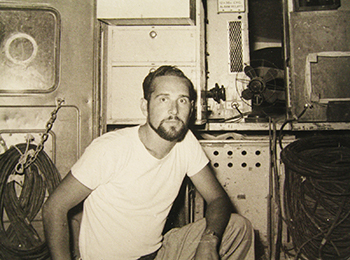Photographic Memories
Charles Ticho (EE ’48) shared his memories of Illinois Tech during his time on campus from 1945–48 following his service in the United States Navy in World War II. Among the memories that Ticho shared was one involving Ludwig Mies van der Rohe, the longtime head of what is now the university’s College of Architecture.

“During my last year at IIT [one of] the first of [Mies] van der Rohe’s new campus buildings opened. Along with the grand opening ceremony, there was also a photographic exhibit of some of his most famous designs. The large photographs and design drawings were hanging in the halls of the building. Suddenly, while walking to class one day, I was dumbstruck. There, hanging on the wall, was a photograph of a house that I passed many times as young boy on Dolni Ulice, the street where our apartment house was located in Brno, Czechoslovakia. The street was on a steep incline, at the top of which it turned right and ran along the crest. This pioneering design of a private villa, the Tugendhat House in Brno, was one of the early designs of Mies van der Rohe and marked him for future greatness in the architecture field.”
Fighting Against Aerosols—Then and Now
After reading the “Stopping the Spread” article in the spring 2021 edition of Illinois Tech Magazine, Paul Gregg (EE ’59) reached out to share his memories of an event that he says took place at IIT Research Institute in the late 1960s involving a United States Army Chemical and Biological Warfare Command project in Fort Detrick, Maryland. The project included creating instrumentation for monitoring droplet-size distribution of an outdoor cloud of small liquid droplets, which are called aerosols.
“Our small group of engineers were able to adapt an existing oscilloscope-type instrument called a ‘nuclear pulse height analyzer’ to the need. This instrument is, as its name implies, used to analyze and display radioactive decay events in a bar graph-style of type [or energy] and rate of occurrence. We used an array of photomultiplier tubes as the data inputs to the instrument instead of radiation detectors. When an aerosol cloud exists in sunlight, each droplet reflects a ‘twinkle,’ or a small brief faint light flash undetectable to the human eye but easily sensed by the high sensitivity of a photomultipler tube….The most important fact I learned is that with a clear liquid carrier most, if not all, bioagents are quickly killed by sunlight UV, lasting perhaps only five or 10 minutes in the infective state. To counter this effect, the offensive group uses a liquid with an opaque dye to shield the agent from UV as much as possible. At the time in 1968, it was just another ‘military’ project for us, and [we] never thought that we would be involved in a real ‘biowar’ with real infective aerosols much later in 2020–2021! There is one very important lesson from this of great use in the present COVID ‘biowar’: outdoors, sunlight UV will rapidly destroy aerosol-borne virus because there is no protective dye in a cough, sneeze, or voice exhalation aerosol….Indoors, the aerosols can linger for hours, as has been shown in videos of clouds taken, no doubt, with equipment similar to ours, but probably much improved with many decades of engineering technology since.”